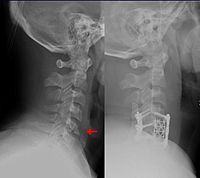
Photo from wikipedia
INTRODUCTION With increasing global unrest and military physician shortages potentially leading to a surgeon draft, we sought to evaluate the readiness of graduating general surgery residents to care for casualties… Click to show full abstract
INTRODUCTION With increasing global unrest and military physician shortages potentially leading to a surgeon draft, we sought to evaluate the readiness of graduating general surgery residents to care for casualties of war. MATERIALS AND METHODS We evaluated the National Data Reports of Surgery Case Logs for general surgery residents from 2009 to 2018 to quantify experience with key procedures that provide critical skills required for wartime surgery. Reported cases from the Accreditation Council for Graduate Medical Education for graduating residents from civilian and military residency programs were analyzed for 28 individual procedures determined to be critical for the care of combat casualties. These included central and peripheral vascular procedures, as well as neck, thoracic, abdominal, and peripheral interventions. RESULTS From 2009 to 2018, there has been a significant decrease in wartime-relevant cases by graduating residents. Notably, these include aorto-iliac/femoral bypasses (50% reduction; 7.1%/year; P < .001), femoral-popliteal bypasses (60% reduction; 6.9%/year; P < .001), femoral-femoral bypasses (30% reduction; 2.6%/year; P < .001), upper extremity amputations (50% reduction; 6.4%/year; P = .016), fasciotomies for trauma (50% reduction; 4.5%/year; P = .013), open repair of ruptured infrarenal aorto-iliac aneurysms (70% reduction; 5.8%/year; P < .001), repair of traumatic aorta or vena cava injuries (70% reduction; 7%/year; P = .007), carotid endarterectomies (40% reduction; 4%/year; P < .001), lung resections (40% reduction; 3.7%/year; P = .001), trauma splenectomies/splenorrhaphy (30% reduction; 2.9%/year; P < .001), and repair of traumatic liver lacerations (30% reduction; 2.5%/year; P = .036). CONCLUSIONS Graduating general surgery residents has limited exposure to wartime critical skills due to a significant reduction in open vascular, head and neck, thoracic, and operative trauma cases. As the threat of global war persists and new graduates continue to deploy worldwide, residency training must be augmented to ensure adequate preparation in case a surgeon draft is required to fulfill demand for military surgeons.
Journal Title: Military medicine
Year Published: 2022
Link to full text (if available)
Share on Social Media: Sign Up to like & get
recommendations!